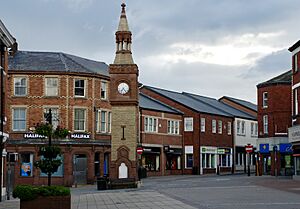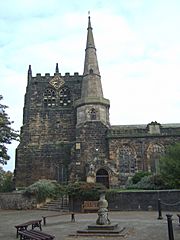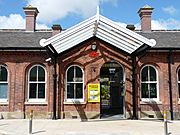Ormskirk facts for kids
Quick facts for kids Ormskirk |
|
|---|---|
| Town | |
 Ormskirk town centre |
|
| Population | 24,073 (2011) |
| OS grid reference | SD415085 |
| District |
|
| Shire county | |
| Region | |
| Country | England |
| Sovereign state | United Kingdom |
| Post town | ORMSKIRK |
| Postcode district | L39 |
| Dialling code | 01695 |
| Police | Lancashire |
| Fire | Lancashire |
| Ambulance | North West |
| EU Parliament | North West England |
| UK Parliament |
|
Ormskirk is a busy market town in Lancashire, England. It is about 13 miles (21 km) north of Liverpool. The town is famous for its delicious gingerbread. In 2011, about 24,073 people lived there.
Contents
About Ormskirk
Ormskirk is built on a sloping hill, which is part of the West Lancashire Coastal Plain. The highest point is 81 meters (266 feet) above sea level. People think Ormskirk was planned out in the 1200s.
The town is in the West Lancashire area. It is also where the main offices for the West Lancashire Borough Council are located. Since Ormskirk does not have a local council, a group called the Ormskirk Community Partnership was started in 2009. This group helps speak for the town. Edge Hill University is also located in Ormskirk.
Ormskirk's History
The name Ormskirk comes from an old Norse (Viking) language. It means Ormr's church. Ormr is a personal name that means "serpent" or "dragon". It is thought that a Viking named Ormr might have settled here and built a church. However, there is no clear proof of this.
Ormskirk is not mentioned in the Domesday Book from 1086. It might have been part of a nearby place called Lathom at that time. Around 1189, the lord of Lathom gave the church of Ormskirk to Burscough Priory. This suggests Ormskirk was a smaller place under Lathom before then.
The Market and Gingerbread
Ormskirk has an open market twice a week, on Thursdays and Saturdays. It is in the town center, which is now a pedestrian area. The market was first allowed by a special permission from King Edward I in 1286. This permission was given to the monks of Burscough Priory. Thursday has been market day in Ormskirk since at least 1292.
For many years, Ormskirk became well-known for its gingerbread. Local women would bake gingerbread at home. They would then sell it to travelers at inns. When the railway came in the mid-1800s, they sold it to passengers at the train station. Even Edward, Prince of Wales (who later became King Edward VII) loved the gingerbread. He would order it specially from the town. Baking gingerbread became a big part of Ormskirk's history.
Parish Church of St Peter and St Paul

The Parish Church of St Peter and St Paul is thought to be where the first church stood. It is the oldest building in Ormskirk. We do not know its exact age, but it has some very old Norman (from the time of the Normans) parts.
This church has strong ties to the Earls of Derby and the Stanley family. Many family members are buried there. This includes Thomas Stanley, the first Earl. He helped Henry VII win the Battle of Bosworth in 1485. Also buried there is James Stanley, who was a Royalist during the English Civil War. He was beheaded in 1651. His body and head are buried in separate places in the church.
This church is special because it is one of only three parish churches in England with both a tower and a separate spire. What makes it truly unique is that both are at the same end of the building! A local story says that Orme had two sisters. One wanted a tower, and the other wanted a spire. So, Orme built both to make them happy.
The spire was first built in the early 1400s. But it blew down in 1731 and was rebuilt later. The large west tower was added around 1548. It was built to hold the bells from nearby Burscough Priory after the Dissolution of the Monasteries. One of these old bells is still in the church today.
Getting Around Ormskirk
The main road through Ormskirk is the A59. It goes north to Preston and south to Liverpool. Another important road, the A570, crosses the town from west to east. This road connects Ormskirk to the M58 motorway, which is about three miles away. The town also has its own bus station, Ormskirk bus station.
Ormskirk's train station was updated in 2009. It is the northern end of the Merseyrail line. From Ormskirk, you can travel by train to Preston. The train line and station first opened on April 2, 1849.
Local Businesses
Ormskirk has several shops and businesses. There is a Morrisons supermarket on Park Road. The Two Saints retail park opened in 2000. It has stores like McDonald's, Argos, Poundland, and Aldi.
An out-of-town business park called The Hattersley Centre opened in 2008. It has stores like Home Bargains, Howdens, and Jewson. In 2019, the Hattersley Centre grew with new units for Lidl and Toolstation.
One of the last big manufacturing businesses in Ormskirk was Atkinson & Kirby. They made hardwood floors and had been in Ormskirk for over 100 years. They moved in 2015. Today, many businesses in the town are professional services. These include lawyers, estate agents, and accountants.
Education in Ormskirk
Ormskirk School is for students aged 11 to 18. It is on Wigan Road. This school was formed when Ormskirk Grammar School and Cross Hall High School joined together. St Bede's Catholic High School is for students aged 11 to 16. It is on St Anne's Road.
Edge Hill University is also in Ormskirk, on St Helens Road. West Lancashire College, which offers further education, used to have a site in the town center. Now, its students go to Skelmersdale. Ormskirk also has a public library.
Media and News
The local newspaper for Ormskirk is the Ormskirk Advertiser. It shares a website with the Liverpool Echo. There are also local radio stations like Sandgrounder Radio and Radio Heartbeat. These stations broadcast to patients at the Ormskirk District General Hospital.
Parks and Green Spaces
Ormskirk has three main parks and other smaller play areas.
- Victoria Park: This is Ormskirk's oldest park, named after Queen Victoria. It has a monument to local heroes from the Boer War and Crimean War.
- Coronation Park: This large park is in the town center. It has play areas for children, a skateboard area, and courts for football and basketball. There is also a duck pond, a bowling green, and a bandstand. The park was created around 1905 to celebrate the coronation of King Edward VII. In 2012, the Ormskirk War Memorial was moved here.
- Ruff Wood: This is a countryside park on the edge of town, on Ruff Lane.
Famous People from Ormskirk
- Jon Culshaw: A famous impressionist (someone who imitates others).
- Kieran Dowell: A footballer who won the U'20 World Cup with England.
- Duncan Ferguson: A well-known footballer who lives in Ormskirk.
- Marianne Faithfull: A famous singer.
- James Hopwood Jeans: A physicist, astronomer, and mathematician.
- Stuart Maconie: A TV presenter who studied here.
- Nicholas Monsarrat: A novelist, who wrote The Cruel Sea.
- Tony Morley: An England and Aston Villa footballer who won the European Cup in 1982.
- Les Pattinson: A former member of the band Echo & the Bunnymen.
- Jonathan Pryce: A well-known actor.
- John Rimmer: An athlete who won two gold medals at the 1900 Summer Olympics.
- Stephen Warnock: An England and Liverpool footballer.
Images for kids
See also
 In Spanish: Ormskirk para niños
In Spanish: Ormskirk para niños






